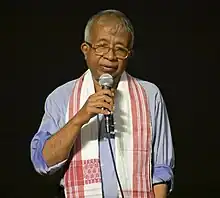D. J. Saikia
Dhruba J. Saikia is an Indian astrophysicist and radio astronomer. He is currently the head of the Teaching Learning Centre and National Resource Centre for Astronomy at the IUCAA in Pune, India.
Dhruba J. Saikia | |
|---|---|
 Dhruba J. Saikia | |
| Born | 1956 |
| Alma mater | TIFR |
| Known for | Unified Scheme for Quasars, Radio Astronomy |
| Awards | Prof. M.K. Vainu Bappu Gold Medal of the Astronomical Society of India in 1990. |
| Scientific career | |
| Fields | Astrophysics, Radio Astronomy |
| Institutions | IUCAA, National Centre for Radio Astrophysics, Jodrell Bank Observatory |
| Thesis | (1985) |
| Doctoral advisor | Vijay Kapahi, Govind Swarup |
He previously served as a professor at the National Centre for Radio Astrophysics (NCRA),[1] part of the Tata Institute of Fundamental Research (TIFR). He was also the Vice-Chancellor at Cotton University[2] in Guwahati, Assam between 2012 to 2017.
Early life and education
In 1975, he earned a B.Sc. in Physics with Honours from Hindu College, Delhi, and in 1977, he obtained an M.Sc. in Physics from Gwyer Hall, Delhi.
Career and research
In 1977, Saikia embarked on a career in radio astronomy, joining the radio astronomy group at TIFR. He completed his PhD in 1985 at the University of Bombay, under the guidance of Vijay Kapahi and Govind Swarup. His doctoral research focused on radio jets and compact features in radio galaxies and quasars, leading to the development of an early version of the unified scheme for lobe- and core-dominated quasars.
Throughout his career, Saikia has participated in major astronomy projects, including LeMMINGs[3] and CHANG-ES. His research spans various aspects of astronomy and astrophysics, including active galaxies, luminous radio galaxies, and quasars. He has also made significant contributions to the understanding of the early Universe through deep radio continuum surveys and the study of neutral hydrogen 21-cm absorbers at cosmological distances. In recent times he has been actively involved in the investigation of giant radio galaxies[4] via the SAGAN project.
Editorial work
Saikia served as the Editor of the Bulletin of the Astronomical Society of India (BASI),[5] a quarterly journal published in English by the Astronomical Society of India (ASI).[6] His editorial work includes the publication of the special 2011 March issue of BASI, along with several other articles, as a book titled "Fluid Flows to Black Holes."[7] This book, co-edited with Virginia Trimble, is a tribute to Chandrasekhar on his birth centenary.
References
- "D. J. Saikia". National Centre for Radio Astrophysics. Retrieved 2023-10-13.
- "Guwahati: Cotton university gets new vice-chancellor". The Times of India. 2012-06-02. ISSN 0971-8257. Retrieved 2023-10-13.
- "e-MERLIN". www.e-merlin.ac.uk. Retrieved 2023-10-13.
- https://astronomycommunity.nature.com/posts/giant-radio-galaxies-the-cosmic-behemoths#:~:text=Giant%20radio%20galaxies%2C%20which%20harbour,from%20few%20parsecs%20to%20megaparsecs.
- "BASI :: Bulletin of the Astronomical Society of India". www.astron-soc.in. Retrieved 2023-10-13.
- "Latest Updates | Astronomical Society of India". www.astron-soc.in. Retrieved 2023-10-13.
- Saikia, D J; Trimble, Virginia. Fluid Flows to Black Holes: A Tribute to S Chandrasekhar on His Birth Centenary. WORLD SCIENTIFIC. doi:10.1142/8327. ISBN 978-981-4374-76-7.
External links
- D. J. Saikia publications indexed by Google Scholar